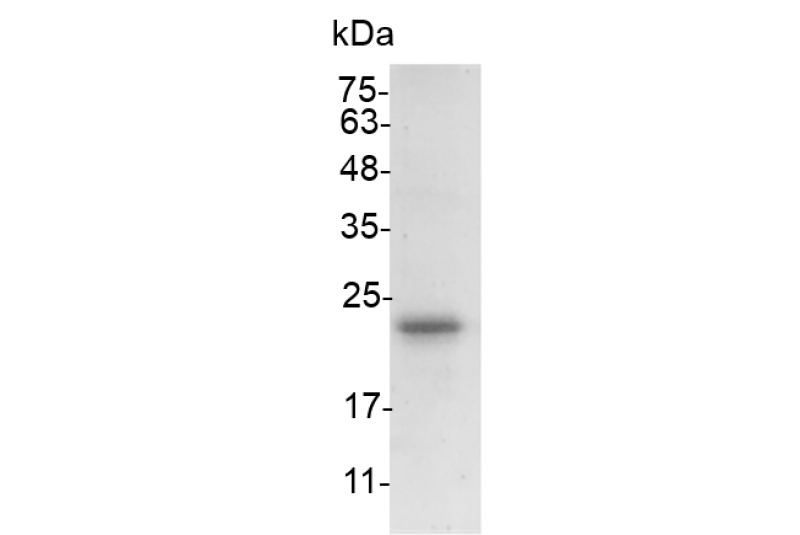HRV 3C Protease
HRV 3C Protease is a recombinant form of the 3C protease derived from
human rhinovirus 14 express ed in E. coli (specific activity 1800-2000
U/mg). This product is a highly purified recombinant 6XHis fusion protein.
This protease requires neither metal nor cofactors for activity. HRV 3C
Protease recognizes the cleavage site: Leu-Glu-Val-Leu-Phe-Gln Gly-Pro
(LEVLFQ GP).
human rhinovirus 14 express ed in E. coli (specific activity 1800-2000
U/mg). This product is a highly purified recombinant 6XHis fusion protein.
This protease requires neither metal nor cofactors for activity. HRV 3C
Protease recognizes the cleavage site: Leu-Glu-Val-Leu-Phe-Gln Gly-Pro
(LEVLFQ GP).
Catalog number:
C09002-bulk / C09002-1000U / C09002-10000U HRV 3C Protease
C09002-B-bulk / C09002-B-1 10X HRV 3C Cleavage Buffer
Package:
Customized package / 1,000 U / 10,000 U HRV 3C Protease
Customized package / 10 mL 10X HRV 3C Cleavage Buffer
Source:
Escherichia coli
Endotoxin level:
<1 EU per 1 μg of the protein by the LAL method.
Activity:
One unit of HRV 3C Protease is defined as the amount of enzyme that will cleave>95% of 0.1 mg HRV 3C cleavage control protein in 150 mM NaCl, 50 mM Tris-HCl pH 7.5, at 4°C for 16 h.
Purity:
>98% as determined by SDS-PAGE. Purified by Ni-NTA chromatography.
Formulation:
The protein was lyophilized from a solution containing 50 mM Tris, 150 mM NaCl, 1 mM EDTA, 1 mM DTT, 0.04% Tween20, 8% trehalose, 8% mannitol.
Reconstitution:
It is recommended to reconstitute the lyophilized protein in sterile H2O and incubate the stock solution for at least 20 min to ensure sufficient re-dissolved.
Storage:
Lyophilized protein should be stored at -20°C. Upon reconstitution, protein aliquots should be stored at -20°C.
HRV 3C Protease Cleavage Buffer should be stored at -20°C or 4°C.
Component:
Shipping Conditions:
Blue ice
C09002-bulk / C09002-1000U / C09002-10000U HRV 3C Protease
C09002-B-bulk / C09002-B-1 10X HRV 3C Cleavage Buffer
Package:
Customized package / 1,000 U / 10,000 U HRV 3C Protease
Customized package / 10 mL 10X HRV 3C Cleavage Buffer
Source:
Escherichia coli
Endotoxin level:
<1 EU per 1 μg of the protein by the LAL method.
Activity:
One unit of HRV 3C Protease is defined as the amount of enzyme that will cleave>95% of 0.1 mg HRV 3C cleavage control protein in 150 mM NaCl, 50 mM Tris-HCl pH 7.5, at 4°C for 16 h.
Purity:
>98% as determined by SDS-PAGE. Purified by Ni-NTA chromatography.
Formulation:
The protein was lyophilized from a solution containing 50 mM Tris, 150 mM NaCl, 1 mM EDTA, 1 mM DTT, 0.04% Tween20, 8% trehalose, 8% mannitol.
Reconstitution:
It is recommended to reconstitute the lyophilized protein in sterile H2O and incubate the stock solution for at least 20 min to ensure sufficient re-dissolved.
Storage:
Lyophilized protein should be stored at -20°C. Upon reconstitution, protein aliquots should be stored at -20°C.
HRV 3C Protease Cleavage Buffer should be stored at -20°C or 4°C.
Component:
| Catalog number | C09002-1000U | C09002-10000U |
| HRV 3C Protease | 1,000 U | 10,000 U |
| 10X HRV 3C Cleavage Buffer | 10 mL | 10 mL |
| 10X HRV 3C Cleavage Buffer: 1.5 M NaCl, 0.5 M Tris HCl, pH 7.5 | ||
Shipping Conditions:
Blue ice
Cleavage procedure:
.png)
Fig. The control protein was cleaved by HRV 3C protease at 4˚C for 16h.
Notes:
| Component | Volume (μL) |
| HRV 3C Protease | X |
| 100 μg protein | Y |
| 10X HRV 3C Cleavage Buffer | 10 |
| H2O | 90-X-Y |
| Total volume | 100 |
- Incubate the reaction mixture at 4°C for 16 hours or overnight.
- Determine cleavage level of the samples by SDS-PAGE analysis.
- HRV 3C protease: target protein ratio of 1:25~1: 100 (U/μg) is used for most fusion protein cleavage.
- If shorter incubation time is required, more amount of HRV 3C protease or higher temperature (RT) can be implemented.
Reaction can be performed at 4°C-37°C. 4°C is recommended as the starting standard.
.png)
Fig. The control protein was cleaved by HRV 3C protease at 4˚C for 16h.
Notes:
- Cleavage efficiency may differ based on structure and properties of each target protein, we recommend testing several enzyme-to-substrate ratios, temperatures and incubation times.
- HRV 3C Protease reactions can be performed in a buffer which is optimal for the target protein. Reducing reagents (e.g., DTT) or salts (e.g., NaCl) can be added for cleavage efficiency evaluation.


